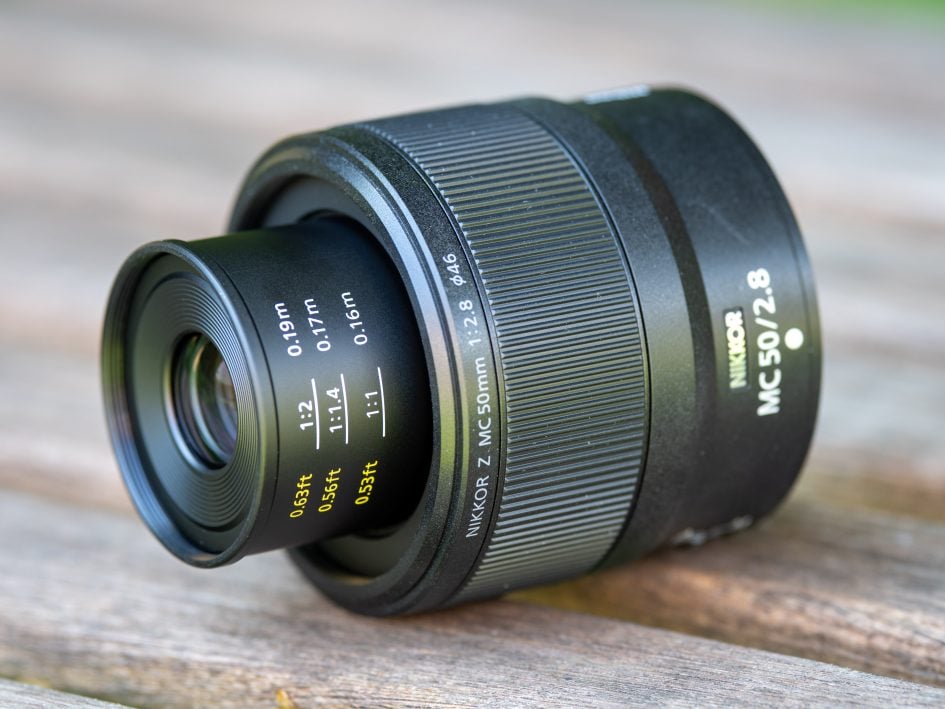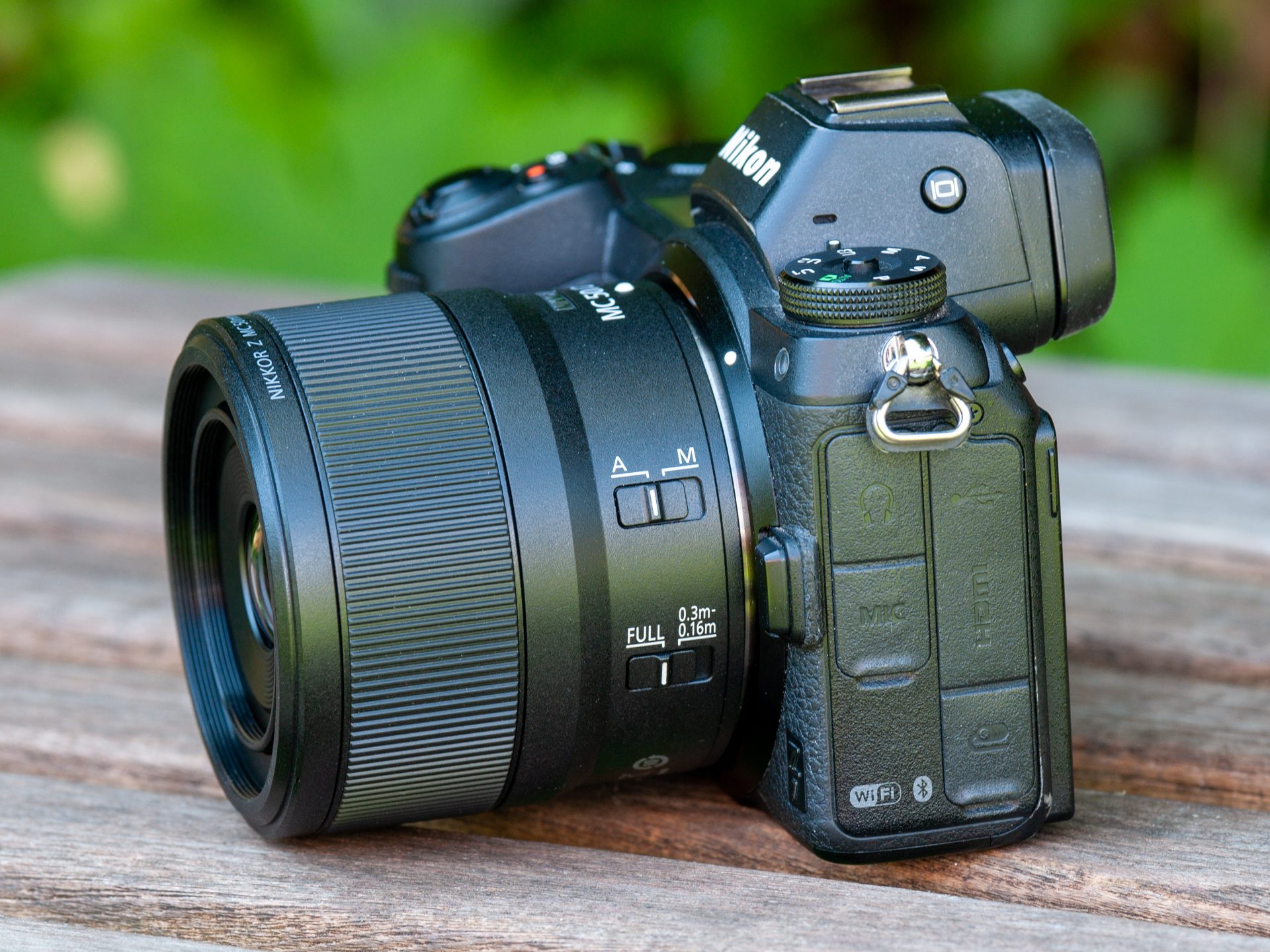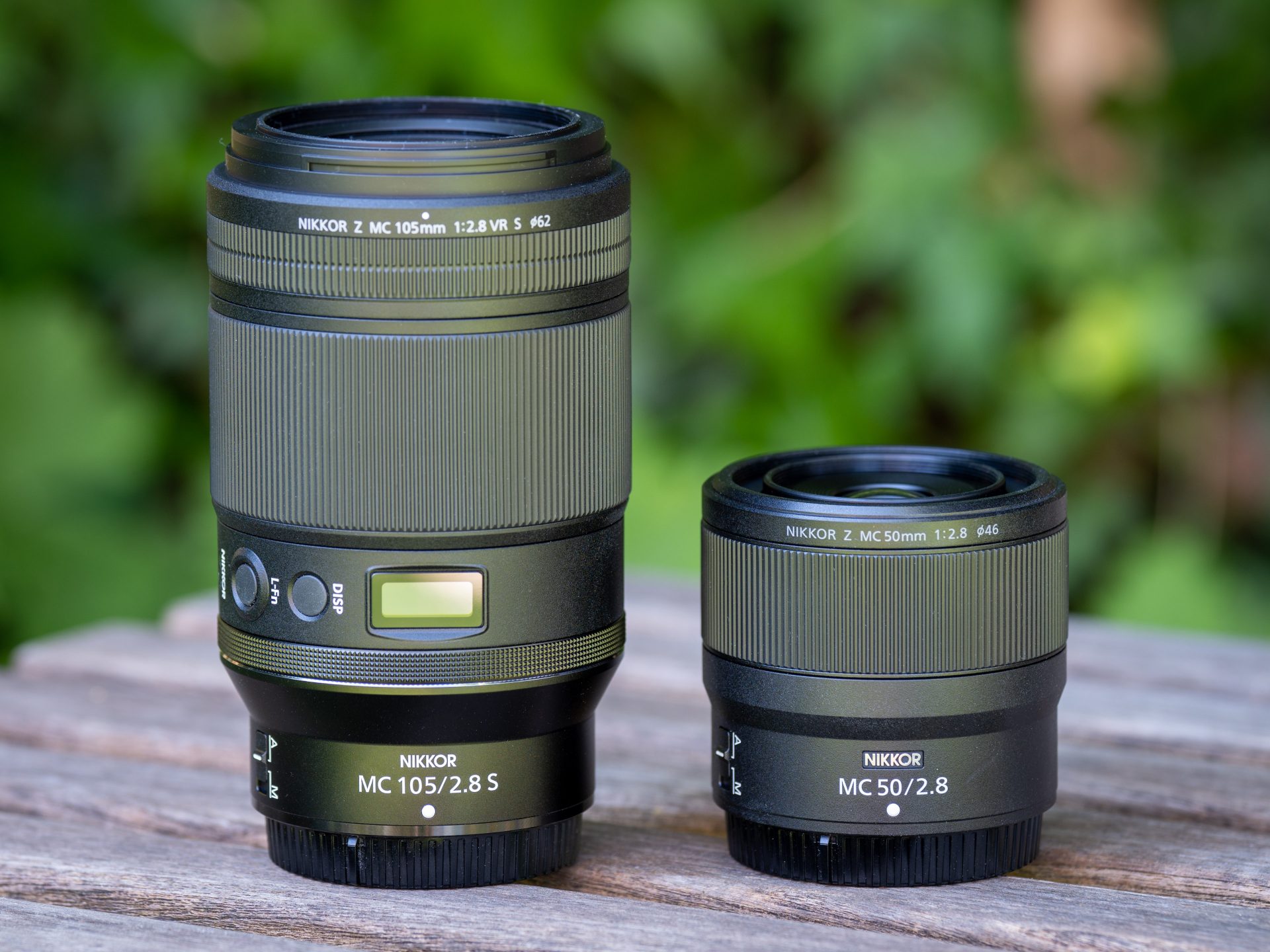Nikon Z MC 50mm f2.8 review
-
-
Written by Thomas
Intro
The Nikon Z MC 50mm f2.8 is one of two macro lenses for Nikon’s Z-mount mirrorless cameras – the other being the Z MC 105mm f2.8 VR S. It achieves 1:1 (1x) magnification without the use of bellows or extension tubes and is corrected for full-frame cameras. It can fill the frame with a subject of 24 x 36mm (0.94 x 1.42in.) at 1x magnification. The new lens is the shortest macro lens in Nikon’s F-mount or Z-mount line-up covering full-frame sensors as the AF-S DX Micro-Nikkor 40mm f2.8 G is only corrected for DX sensors where it produces an angle of view equivalent to a 60mm lens, and the AF-S Micro-Nikkor 60mm f2.8 G ED has a 20% longer focal length.
The new Z MC 50mm f2.8 has autofocus, full weather sealing including fluorine coating, and a focus limiter. It was announced in June 2021 at a price of 729 EUR / 647 USD / 649 GBP.
Facts and features
Let’s compare the Nikon Z MC 50mm f2.8 (“Z-Nikkor” for short) to the AF-S Micro-Nikkor 60mm f2.8 G ED (“60mm F-Nikkor”) and AF-S DX Micro-Nikkor 40mm f2.8 G (“40mm F-Nikkor”). As usual I’ve rated the features with a [+] (or [++]), when it’s better than average or even state of the art, a [0] if it’s standard or just average, and [-] if there’s a disadvantage.
Size (diameter x length): 75 x 66mm (2.9 x 2.6in.) plus 6mm for the tiny lens hood (50mm diameter). The Z-Nikkor extends when focusing to minimum object distance by 26mm. The 60mm F-Nikkor is 73 x 89mm + lens hood, the 40mm F-Nikkor is 69 x 65mm + lens hood. Plus you need to add 30mm for the FTZ adapter to use the F-Nikkors on a Nikon Z camera. The new Z-Nikkor is indeed the most compact macro lens to use on a Nikon Z camera. [+]
Weight: 260g (9.2 oz.) + 5g for the lens hood. The 60mm F-Nikkor is 425g (15.0 oz.), the 40mm F-Nikkor weighs 235g (8.3 oz.), both without lens hood. As the FTZ-adapter for the F-Nikkors adds another 133g (4.7 oz.) the new Z-Nikkor is the lightest macro lens on a Nikon Z camera. [+]
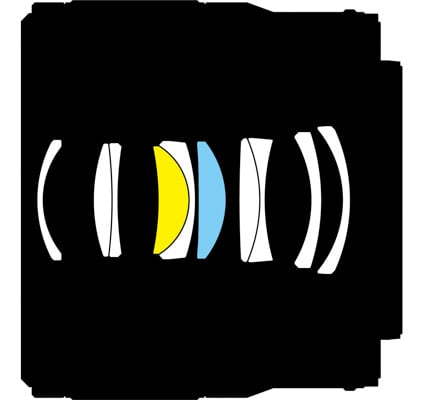
Optics: 10 elements in 7 groups including one special dispersion element and one aspherical element. The lens has fluorine-coating on the front element to repel water, dust, and dirt and make cleaning easier. The 60mm F-Nikkor has 12 elements in 9 groups with one special dispersion and two aspherical elements, the 40mm F-Nikkor has 9 elements in 7 groups with no special elements. [+]
All three lenses in this comparison go down to 1:1 magnification, the Z-Nikkor even a bit beyond (1:0.93). But due to their short focal lengths closest focus distances are around 0.16m (0.52ft.) with results in extremely short working distances of only 5.6cm (2.2in.) for the Z-Nikkor, 5cm for the 60mm F-Nikkor, and 3cm for the 40mm F-Nikkor. The Z-Nikkor achieves a magnification of 1:10 at a distance of 0.59m (1.9ft.). Plus it works with Nikon’s ES-2 film digitizing adapter. [+]
Image stabilization: None of the three lenses in this comparison offers optical stabilization. But Nikon’s full-format Z bodies provide built-in sensor-shift stabilization over 5 axis for any Z-Nikkor – plus an optional electronic stabilization in video mode. For F-mount lenses used on the FTZ adapter the body-based image stabilization of a Nikon Z camera provides roll, pitch, and yaw correction. [0]
Filter-thread: 46mm, which is pretty unusual. So you probably need to get a new set of filters. The 60mm F-Nikkor uses 62mm filters, the 40mm F-Nikkor 52mm filters. [0]
Autofocus: All three lenses in this comparison offer autofocus. So focus bracketing can be done with the built-in camera function. Manual-focus override is by simply turning the focus ring – if you didn’t assign another operation to this multi-function ring on the Z-Nikkor. The focus ring of the Z-Nikkor has the usual variable gearing to assist in precise focusing which is very important especially in macro photography. The Z-Nikkor also sports a focus-limiter which can prevent the lens to search focus farther away than 0.3m (1ft.). [+]
Aperture: The multi-function control ring of the Z-Nikkor can be assigned to operate the aperture, exposure compensation, ISO, or focus. It automatically falls back to its customary focus control when the lens is switched to manual focus. Although the lens control ring has not the same benefit as having a focus ring plus a dedicated aperture ring on the lens it gives you more flexibility to control one of the more important shooting parameters directly from a nice ring on the lens. The F-Nikkors don’t have an aperture control ring. Effective focal ratio on the Z-Nikkor loses 2 stops (to f5.6) at 1:1 magnification. [+]
Lens profile: The Z-Nikkor comes with a lens profile which can be controlled from the camera. Vignette control offers the usual options of High, Normal, Low and Off. Diffraction compensation and Auto distortion control can be activated or deactivated. The F-Nikkors have lens profiles in Adobe’s RAW converter. [+]
The Z Nikkor and 60mm F-Nikkor cover full frame/FX or smaller. The 40mm F-Nikkor only covers the DX image circle. [+]
Price: 729 EUR (incl. 19% VAT) / 647 USD / 649 GBP. The 60mm F-Nikkor is 590 EUR / 600 USD / 690 GBP, the 40mm F-Nikkor costs 280 EUR / 280 USD / 270 GBP. [0]
Use with teleconverter: Nikon’s Z teleconverters cannot be used with any of the lenses in this comparison. [0]
The lens comes with the usual flimsy pouch with no strings to pull it close. The lens hood is included but is only 6mm deep and has to be mounted in the filter thread. The F-Nikkors come with a soft pouch and reversible lens hood. [0]
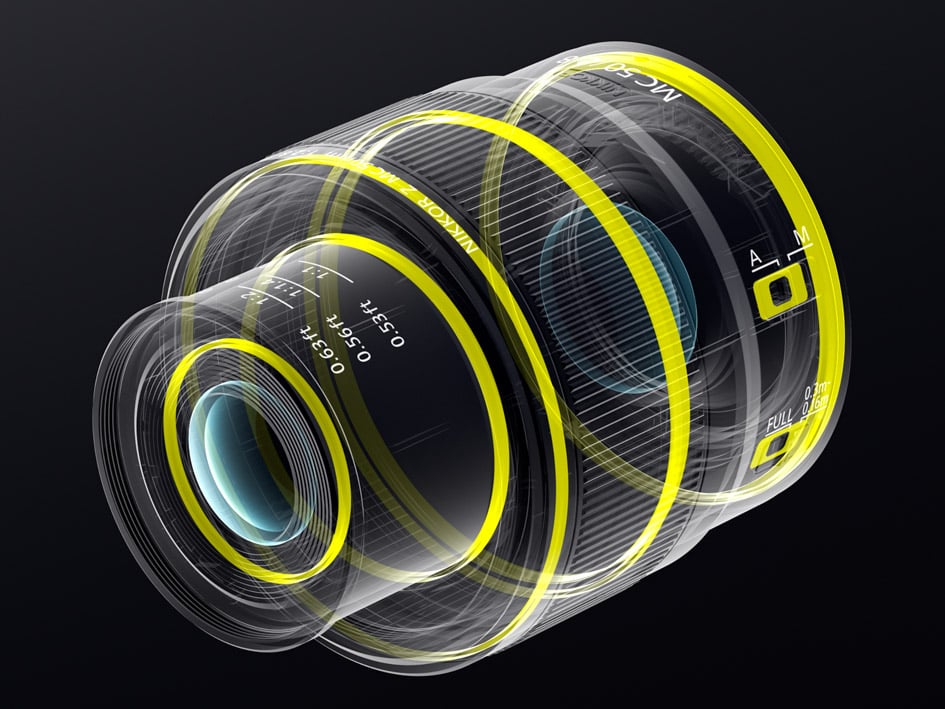
Sealing: Yes, a rubber grommet at the lens-mount plus further special weather-sealing throughout the construction. [+]
At a score of 0[-]/6[0]/9[+] the Nikon Z MC 50mm f2.8 looks like a well featured small and light macro lens which also doubles up as a standard lens for other photographic applications. It is fully weather sealed, has fluorine-coating, and a multi function ring. With autofocus it can use the focus bracketing feature of Nikon Z bodies and take a great deal of hassle out of focus stacking. Just keep in mind that with its short focal length working distances can be extremely short which might spook small critters.
Above: Nikon Z MC 105mm f2.8 VR S (left), Nikon Z MC 50mm f2.8 (right)
Alternatives
If you’re looking for macro lenses offering a magnification of at least 1:1 (1x) and focal lengths around 50mm there are few other alternatives in addition to the above mentioned AF-S Micro-Nikkor 60mm f2.8 G ED and AF-S DX Micro-Nikkor 40mm f2.8 G:
- Laowa has the 60mm 2.8 2:1 Ultra-Macro which is a DSLR design from 2016. At infinity focus the lens only fills the DX frame but at macro distances it covers a full-frame sensor. The lens is available for Nikon F mount and costs about 430 EUR / 400 USD / 370 GBP. It offers the unique capability to go down to 2:1 (2x) magnification but it has no image stabilization, no autofocus, a manually operated aperture and does not transfer EXIF data to the camera.
But Nikon also has the Z MC 105mm f2.8 VR S which costs 1099 EUR / 1000 USD / 999 GBP. The lens has a maximum magnification of 1:1 but with its longer focal length working distances are double of what the Z MC 50mm f2.8 offers. It also has optical image stabilization, an additional function button, plus an OLED display to indicate aperture or focusing distance and depth-of-field, or magnification.
Focus
Focus accuracy and repeatability is critical to consistently produce sharp shots. Repeatability (the accuracy of focus on the same subject after repeated focus-acquisition) of the Nikon Z MC 50mm f2.8 is pretty good (measured 98.4% in Reikan FoCal) with no outliers over a series of 40 shots. There is almost no focus variation whether the lens focuses from a closer distance or from infinity but I detected some hunting when the lens was far out of focus. The lens focuses in around 0.5 sec from infinity to 0.59m (1:10 magnification), which is pretty fast.
The focus ring is 24mm wide. Its rubber surface is structured for better grip and can be operated with one finger. AF-operation of the lens in photo-mode can be heard as a low hum from the outside but if you record video with the built-in microphone AF is pretty silent.
As you pull focus, you’ll notice some focus breathing: the image became 5% more magnified when I adjusted focus from infinity to 0.59m. This is visible and could be distracting when shooting videos.
Next check out my quality results!
Check prices on the Nikon Z MC 50mm f2.8 at B&H, Adorama, WEX UK or Calumet.de. Alternatively get yourself a copy of my In Camera book or treat me to a coffee! Thanks!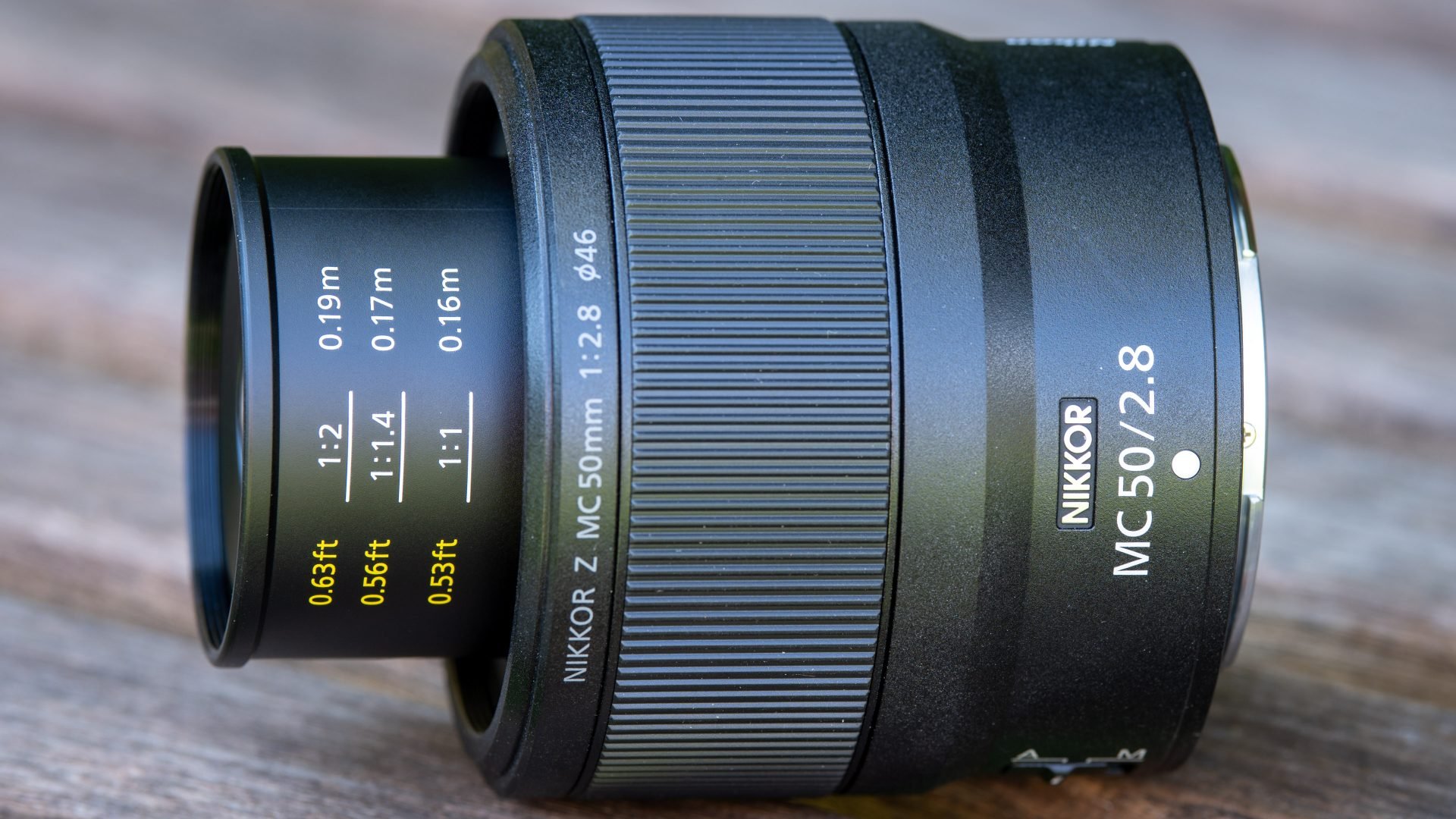
 The Nikon Z MC 50mm f2.8 is a well-featured, small and light macro lens which also doubles up as a standard lens for other photographic applications. It produces sharp images with very little field-curvature – although for best results it should be stopped down two stops which also gets rid of the strong coma. Using focus shift shooting with Nikon Z bodies takes a great deal of hassle out of focus stacking – an essential technique for impressive macro shots. And although working distances can be extremely short the overall capabilities of the Z MC 50mm f2.8 certainly earn it a recommendation.
The Nikon Z MC 50mm f2.8 is a well-featured, small and light macro lens which also doubles up as a standard lens for other photographic applications. It produces sharp images with very little field-curvature – although for best results it should be stopped down two stops which also gets rid of the strong coma. Using focus shift shooting with Nikon Z bodies takes a great deal of hassle out of focus stacking – an essential technique for impressive macro shots. And although working distances can be extremely short the overall capabilities of the Z MC 50mm f2.8 certainly earn it a recommendation.